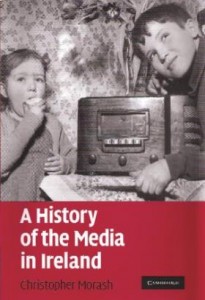A history of the media in Ireland
Published in 18th-19th Century Social Perspectives, 18th–19th - Century History, 20th Century Social Perspectives, 20th-century / Contemporary History, Book Reviews, Early Modern History (1500–1700), Early Modern History Social Perspectives, Issue 2 (March/April 2010), Reviews, Volume 18A history of the media in Ireland
Christopher Morash
(Cambridge University Press, £45)
ISBN 9780521843928
 The Revd Alexander R. C. Dallas was convinced that the second coming of Christ was due in 1872. Unconvinced that the Catholics of Ireland would appreciate this, in January 1846 he arranged for a simultaneous letter-drop across the country. Copies of a tract entitled A voice from heaven would appear in the letter-boxes of leading Catholics at roughly the same time, a minor miracle that would remind them of the error of their ways and, at the very least, keep popery on its toes.
The Revd Alexander R. C. Dallas was convinced that the second coming of Christ was due in 1872. Unconvinced that the Catholics of Ireland would appreciate this, in January 1846 he arranged for a simultaneous letter-drop across the country. Copies of a tract entitled A voice from heaven would appear in the letter-boxes of leading Catholics at roughly the same time, a minor miracle that would remind them of the error of their ways and, at the very least, keep popery on its toes.
What is notable about this incident is the meeting of a new technology (the postal service) and an old system of belief (evangelical Protestantism). Christopher Morash’s excellent book is studded with such revealing anecdotes. In 230 pages it offers a fascinating holistic overview of the role that various forms of media have played in Irish history. It is a significant contribution to the neglected field of Irish cultural history, for it is by no means restricted to the nuts-and-bolts technicalities of communication: its particular strength lies in the way Morash deftly interweaves the various methods of disseminating information with the broader significance of that dissemination. At the core of the book is print culture, introduced to Ireland in the sixteenth century as little more than a tool of the colonial authorities. While the printed word would, over time, outstrip this role, its origins left an enduring cultural division: print culture in Ireland remained overwhelming Anglophone and thereby excluded the Irish-speaking majority (they would remain largely excluded from formal media until at least the end of the nineteenth century). In the meantime, print went from strength to strength, as in the eighteenth century the rise of provincial printing and increasing, if slow, access to news from abroad facilitated the growth of a vigorous newspaper industry. Unauthorised reprints of books published abroad (especially in Britain) also fed a demand for print that was inextricably linked to an inevitable growth in literacy, at least in some segments of the population. With this came another development: the role of the media in shaping ideas and beliefs as opposed to merely transmitting information. The old chestnut of the ‘public sphere’ seems appropriate when describing a paper such as Dalton’s Impartial Newsletter, which in 1734 was printed on only one half of a full sheet of paper, the better to facilitate readers leaving their own opinions and scraps of news for the benefit of those who might come after them and do likewise. By the 1790s the Northern Star, as an organ of the United Irishmen, had taken the role of attempting to mould public opinion to a new level, a process repeated by later periodicals such as The Nation. Morash is acutely aware of the significance of technology in the dissemination and development of ideas and systems of belief (up to and including Irish nationalism). The rise of rail travel, steam power and telegraph communications in the nineteenth century rapidly cut the time it took for information to travel, and further locked Ireland into a transatlantic cultural world (a development that the Fenians, amongst others, exploited with great success).
The book takes the form of a synthetic essay, interspersed with a number of illuminating stand-alone case-studies: the outbreak of the 1641 rebellion, the rise of the Northern Star in the 1790s, the Pigott forgeries, the world’s first radio broadcast from the GPO in 1916, the brutal (and subsequently televised) RUC assault on civil rights marchers in Derry in October 1968, and Live Aid. What is obvious from this selection is that Morash does not confine himself to print: he also examines the role of the cinema, of radio and of television. After independence the media could be seen as a conduit for the various evils that Ireland had to remain wary of: jazz, for example, or ‘evil literature’ (though when discussing the latter Morash dwells on the canonical, rather than equally banned works like the intriguingly titled Hot dames on cold slabs). Yet 70 years later the extraordinarily rapid developments in information technology that came towards the end of the twentieth century, on both global and local scales, were undoubtedly handmaidens to the economic boom of the 1990s and the changes that followed in its wake. It is striking to read how patterns and trends still evident in contemporary media had crystallised centuries ago. In early eighteenth-century Ireland, notes Morash, ‘it was common practice to present items from English or Dutch newspapers as if they were eye-witness accounts’. In the early 21st century it was common practice for correspondents in the Persian Gulf to present items from international news agencies as if they were eye-witness accounts from the American invasion of Iraq. So it goes.
A history of the media in Ireland is an excellent book. It very occasionally overstates its case, and its inevitable brevity leaves some tantalising avenues unexplored, but it is (as the blurb says) ‘hugely informative’, brimful of ideas and often brilliantly written. Anyone with an interest in Ireland past or present should learn something from it. HI
John Gibney was formerly an IRCHSS postdoctoral fellow at NUI, Galway.
















